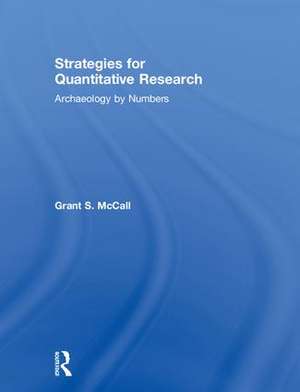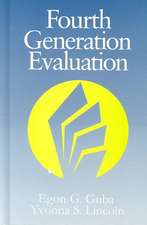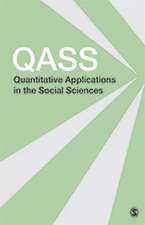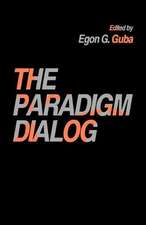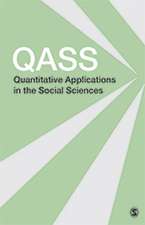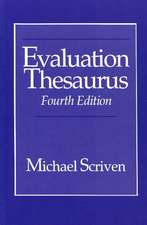Strategies for Quantitative Research: Archaeology by Numbers
Autor Grant S. McCallen Limba Engleză Hardback – 13 feb 2018
Rather than focusing on the mathematics of calculation, this concise handbook selects appropriate forms of analysis and explains the assumptions that underlie them. It deals with fundamental issues, such as what kinds of data are common in the field of archaeology and what are the goals of various forms of analysis.
This accessible textbook lends a refreshing playfulness to an often-humorless subject and will be enjoyed by students and professionals alike.
| Toate formatele și edițiile | Preț | Express |
|---|---|---|
| Paperback (1) | 241.15 lei 6-8 săpt. | |
| Taylor & Francis – 23 feb 2018 | 241.15 lei 6-8 săpt. | |
| Hardback (1) | 764.20 lei 6-8 săpt. | |
| Taylor & Francis – 13 feb 2018 | 764.20 lei 6-8 săpt. |
Preț: 764.20 lei
Preț vechi: 1027.40 lei
-26% Nou
Puncte Express: 1146
Preț estimativ în valută:
146.23€ • 153.08$ • 120.100£
146.23€ • 153.08$ • 120.100£
Carte tipărită la comandă
Livrare economică 05-19 aprilie
Preluare comenzi: 021 569.72.76
Specificații
ISBN-13: 9781138632530
ISBN-10: 1138632538
Pagini: 244
Ilustrații: 56
Dimensiuni: 189 x 246 mm
Greutate: 0.45 kg
Ediția:1
Editura: Taylor & Francis
Colecția Routledge
Locul publicării:Oxford, United Kingdom
ISBN-10: 1138632538
Pagini: 244
Ilustrații: 56
Dimensiuni: 189 x 246 mm
Greutate: 0.45 kg
Ediția:1
Editura: Taylor & Francis
Colecția Routledge
Locul publicării:Oxford, United Kingdom
Public țintă
UndergraduateCuprins
List of Figures
List of Tables
List of Boxes
List of Formula
Preface
Chapter 1: Introduction: How Does Quantitative Analysis Fit Into Archaeological Research?
Chapter 2: Basics: Knowing Your Data
Chapter 3: Preparing Your Data: Aggregation, Standardization, and Transformation
Chapter 4: Numerical and Graphical Approaches to Summarizing Your Data
Chapter 5: Basic Approaches for Statistical Hypothesis Testing Using Univariate Data
Chapter 6: Bivariate Analysis: Linear Regression and Correlation
Chapter 7: Multivariate Techniques for Data Reduction and Pattern Recognition
Chapter 8: Multivariate Approaches to Statistical Hypothesis Testing
Chapter 9: Clustering and Discrimination: Grouping Data According to Similarity
Chapter 10: Conclusion: Numerical Facts in the World of Archaeological Ambiguity
List of Tables
List of Boxes
List of Formula
Preface
Chapter 1: Introduction: How Does Quantitative Analysis Fit Into Archaeological Research?
Chapter 2: Basics: Knowing Your Data
Chapter 3: Preparing Your Data: Aggregation, Standardization, and Transformation
Chapter 4: Numerical and Graphical Approaches to Summarizing Your Data
Chapter 5: Basic Approaches for Statistical Hypothesis Testing Using Univariate Data
Chapter 6: Bivariate Analysis: Linear Regression and Correlation
Chapter 7: Multivariate Techniques for Data Reduction and Pattern Recognition
Chapter 8: Multivariate Approaches to Statistical Hypothesis Testing
Chapter 9: Clustering and Discrimination: Grouping Data According to Similarity
Chapter 10: Conclusion: Numerical Facts in the World of Archaeological Ambiguity
Notă biografică
Grant S. McCall is the Executive Director of the Center for Human-Environmental Research and Associate Professor of Anthropology at Tulane University. He is also the author of Before Modern Humans: New Perspectives on the African Stone Age and (with Karl Widerquist) Prehistoric Myths in Modern Political Philosophy.
Descriere
Strategies for Quantitative Research is a concise and readable textbook on the use of statistics in archaeology and a handbook for professionals in the field aimed at answering commonly occurring questions about the goals of analysis and the assumptions of major statistical models.
